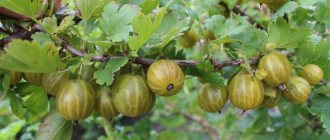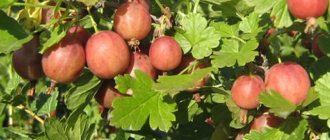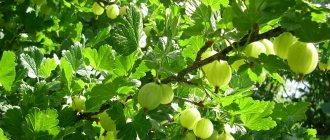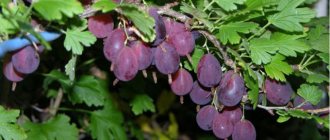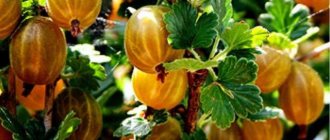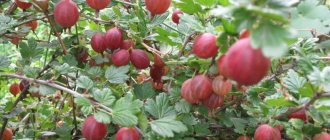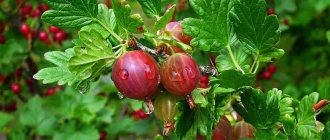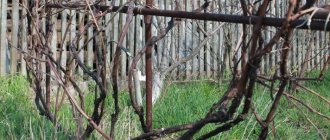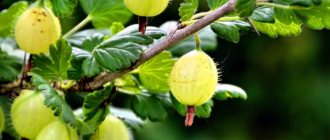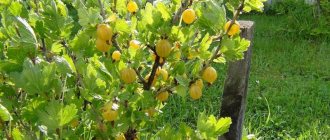History of the variety
The origin of the gooseberry variety Malachite dates back to 1949. At this time, in the city of Michurinsk, breeders of the Central Research Institute of Horticulture named after Michurin, under the leadership of K.D. Sergeeva, developed a new variety by crossing the Black Negus and Date varieties
. At the same time, an application for testing the variety was immediately sent. 10 years later, Malachite was included in the state register and received official permission for cultivation.
On a note!
Among the most favorable areas for growing Malachite gooseberries, the following were identified: Ural, Nizhnevolzhskaya, and Far Eastern.
Gooseberry Malachite: variety description
The bush of the variety is covered with a wide crown with abundant, dense foliage of emerald color
.
The leaves have a round shape and a smooth outline. The upper surface of the leaves is smooth, the lower surface is covered with a small edge. The blades have veins. The Malachite bush itself grows quite tall, up to 1.5 meters in height
. Mature lignified branches have a wide thickness and are intertwined with each other. Young branches also have a curved appearance and are still covered with completely green, soft bark. There is no edge on young branches.
There are thorns
. Most often there are single ones. Sometimes you can see double ones. They are located at right angles to the branch. The thorns on the shoots of the Malachite gooseberry are of medium size (length, width). Between the nodes they are much thinner and smaller in size. Thorns can be found infrequently, and therefore the bush is considered medium-thorny.
Gooseberry Malachite - photo
The berries of the Malachite variety are round. A ripe fruit weighs from 5 to 6 grams
. There is no edge. But the surface of the skin has a waxy coating. The color of the berries fully corresponds to the name - green malachite. The skin is very thin and delicate. You can see veins of lighter shades than the main background. Thanks to their presence, the berry looks transparent. There are many small seeds inside the fruit.
On a note!
Gooseberries contain from 23 to 40 mg per 100 grams of vitamin C, which makes it one of the healthiest berry crops.
The gooseberry variety Malachite has a pleasant aroma and taste.
. Most characterize the taste as sweet and sour, refreshing. The berry acquires this taste due to the presence of a huge amount of sugary substances in it. Their content is approximately 8.6% of the total weight of the fruit.
Resistance to diseases and pests
According to the results of the study, the gooseberry variety Malachite is resistant to powdery mildew and other diseases
. Among them: anthracnose, moth, sawfly.
But he has insufficient immunity to the appearance of rust and septoria
. Susceptible to some other pests.
In this regard, it is important to carry out timely preventive measures for gooseberries against diseases and pests: use pesticides, fungicides and, of course, carry out proper care (pruning, weeding, watering, fertilizing)
.
Currants and gooseberries are often affected by similar diseases and suffer from the same pests.
Useful article!
How to treat currants in the spring to prevent diseases and pests
Mistakes when caring for gooseberries
It often happens that the gooseberry’s immunity suddenly drops. Although it would seem that care was carried out properly, organic nutritional elements were introduced. However, it is worth remembering that an increased dose of nitrogen fertilizers can reduce plant resistance to disease. It is possible to level the situation with a “wedge”, that is, by introducing phosphorus-potassium fertilizers into the soil.
High humidity inevitably leads to the development of fungal diseases. If the plantings are thickened, watering is done incorrectly, and a rainy and cool summer has arrived, then a disaster is inevitable. It is possible to get rid of the scourge by constant ventilation and planting gooseberry bushes at a distance from each other. Mandatory loosening and weeding is the key to healthy growth of shrubs.
It often happens that in the fall the bushes were still healthy, but in the spring they were affected by some kind of disease. This can happen due to the gardener's uncleanliness. Fallen leaves, branches and fruits must be removed during autumn processing of bushes. A fungus or insects can settle in these remains - pests that become more active with the arrival of heat and attack healthy areas of the bush.
When does gooseberry begin to bear fruit after planting?
Photo of gooseberry Malachite
Gooseberries are a self-fertile crop. The first fruits ripen two years after planting in a permanent place of growth. Malachite gooseberry can bear fruit for 15 years, subject to proper care and favorable conditions. The yield level remains constant.
Currant varieties!
Lazy Yadrenaya Dobrynya
Planting gooseberries Malachite
In order for gooseberries to develop well and produce a good, high-quality harvest, it is necessary, first of all, to choose the right place for planting.
It must meet the following conditions:
- be protected from drafts;
- good sunlight;
- a slight elevation is the best condition for gooseberries, in the lowlands the plant may get sick and die;
- groundwater should be located as deep as possible in the soil;
- good drainage;
- clean land, free from weeds;
- The most suitable soil for growing gooseberries is loamy or black soil.
Malachite can be planted in 2 terms. In the central zone of the country, it is recommended to plant cuttings in early autumn (September). There is enough time before the onset of winter frosts for the root system to take root properly.
Important!
In harsher and colder climates, such as in Siberia or the Urals, it is worth planting Malachite gooseberries with the onset of spring, immediately after the snow melts and before the buds on the trees open.
Planting gooseberries
Instructions for planting gooseberries Malachite
Since the shrub has a fairly spreading crown, it is necessary to maintain a distance between seedlings
. Should be at least 1 meter when grown in one row. A distance of 1.5-2 meters is maintained between rows. There should be no other trees or buildings nearby at least three meters.
The size of the hole for planting is 40 x 40 x 40 cm.
Nutrient soil is specially prepared for each hole.
. It consists of humus, which is already sufficiently rotted, or compost (in a volume of 10 kg) and 100 grams of wood ash. For depleted soil, add superphosphate (3 tablespoons).
Gooseberry cuttings are planted at a certain angle
. Place 2 or 3 buds deep so that the bush branches well as it grows.
Sprinkle the root system with soil, covering half of the hole.
. The soil is compacted. The earth is moistened with a bucket of water.
After complete absorption of moisture into the soil, dry soil is poured into the planting hole up to the very surface of the earth.
. Mulching is carried out on top. The thickness of the soil layer is from 5 to 8 cm. Peat, sawdust, manure, and straw are used for mulching.
At the final stage, the Malachite gooseberry seedling is shortened, cutting it
, leaving only 5-6 buds above the surface of the earth.
The planting process is quite simple. For a good result, it is important not to neglect the rules described above.
Growing
High-quality plant care should begin from the moment the seedlings are planted in open ground. Before planting, you should dig a hole up to 40 cm deep in advance. It is imperative to maintain a distance between bushes of at least 1 m.
In order for the seedlings to take root well, they must be planted in nutritious soil. To do this, the pit is filled with fertilizers. In this particular case, wood ash is best suited. It is mixed with soil in a ratio of 10 kg of soil per 100 g of wood ash.
After planting the seedling, it is watered abundantly. Next, the gooseberries need to be constantly watered, especially if the temperature outside is high.
As the plant develops, it is necessary to periodically loosen the soil. It is necessary to ensure that the root system receives sufficient oxygen. In this case, you should be careful, since the root system of the gooseberry is located very close to the surface, so careless or too deep loosening can damage it.
How to water gooseberries
Malachite is watered as needed. A sign for watering is dry soil. The shrub reacts very sensitively to drought, so you need to be especially careful about this point.
There are three periods when gooseberries are especially sensitive to lack of water:
- formation, growth of young branches;
- formation of ovaries;
- pouring and the berries reaching full ripeness.
In conditions of no rain, gooseberries should be watered once every 7 days.
. One bush requires at least 10 liters of water.
To reduce the number of waterings and simplify the maintenance process, experienced gardeners recommend covering the root area with mulch. Organic is perfect as mulch for gooseberries. It noticeably slows down the growth of weeds and supplies the bush with nutrients as needed.
Diseases of the variety and ways to combat them
The gooseberry variety “green malachite” has a great advantage over other varieties of this crop; it has good and stable immunity. But at the same time, most experienced gardeners recommend taking preventive measures in spring to protect shrubs. Perform preventive measures according to the following schedule:
Protecting shrubs from various defects and parasites is much easier than trying to deal with a problem that has already appeared. At the same time, do not forget that the best prevention of illnesses and diseases is timely weeding, fertilizing and watering. It is these measures that help minimize all attacks on gooseberries.
Pruning gooseberries Malachite and crown formation
Gooseberry: CORRECT Pruning of the bush
The first pruning of Malachite gooseberries is done after planting in a permanent place of growth.
. The shoots are shortened to 6 buds.
How to prune gooseberries after planting - photo
The second pruning is carried out before the movement of juices and swelling of the buds
.
The next gooseberry pruning is carried out in the fall.
. Only the most prolific branches (about five) are left for wintering. All others are simply cut to the very surface of the soil.
Important!
After trimming the gooseberries, be sure to treat the cuts with garden varnish. This will help prevent the possibility of infection.
In the autumn, remove all old branches, as well as branches with damage.
, shoots that grow inside the crown and interfere with the growth of other branches. In addition, the upper parts of the shoots, where the berries have become smaller, are also removed. Branches that are 5 years old are also removed.
Landing
Proper planting is important for the subsequent successful growth of the plant. Before planting, it is necessary to study the timing and technology, choose a location and prepare the seedlings.
Deadlines
Gooseberries are planted in the fall after the end of the growing season. Planting can also be done in the spring before active sap flow begins. Autumn planting is more preferable, which allows the gooseberries to better take root and harden before the onset of cold weather.
Choosing a suitable location
The growth of the crop is influenced by the place of cultivation. Plant plants in an area with the following parameters:
- lack of shadow;
- protection from sharp gusts of wind;
- the soil is loamy or sandy loam, loose and fertile;
- groundwater is not higher than 1.5 m.
Important! It is not advisable to plant bushes in low-lying areas. This will cause moisture to accumulate in the area of the root system, which will cause the plant to wither.
Selection and preparation of planting material
Planting material should be selected according to a number of criteria. They say about the quality of the seedling:
- shoot height 30 cm;
- 3–4 branches;
- developed root system.
Before planting, the seedlings are removed from dried branches and roots.
Planting scheme
For planting, holes are dug 0.6 m deep and 0.5 m wide. The optimal distance between bushes is 2 m. A week before planting, a fertile mixture is added to the holes:
- 5 kg of soil;
- 100 g ash;
- 80 g superphosphate;
- 40 g of potassium sulfate.
Plant using the following technology:
- Place the seedling in the hole, straighten the roots.
- Fill the free space with soil.
- Compact the tree trunk circle.
- Water the bush under the trunk.
Gooseberry Malachite: how to properly fertilize
Fertilizing is carried out depending on the seasons. There are spring and autumn feeding of gooseberries Malachite
.
Spring feeding is carried out before the buds begin to appear.
, it is called nitrogen fertilizing. The fertilizer contains urea and ammonium nitrate (45 g and 60 g, respectively).
In summer, fertilizer is applied during the formation of buds.
. Phosphorus-potassium fertilizers are used in a volume of 30-40 g. You can replace 200 grams of simple ash.
Feeding berry bushes - video
Autumn fertilizing is carried out after the final harvest.
. Its goal is to strengthen the roots for the winter. The fertilizer consists of superphosphate and potassium chloride (30 grams of each).
Fertilizer application goes well with watering.
Attention!
The indicated dosages of the funds are applied both in the dry method, simply by shallow digging, and in the liquid method - in the form of a solution (per 10 liters of water).
Care
Proper care of Malachite gooseberries involves regular pruning, fertilizing twice a year and providing the plant with sufficient moisture during the summer season.
The pruning procedure is carried out in the spring before the buds swell and in the fall after the leaves fall off. In the spring, only branches that have frozen over the winter and damaged are removed; crown-forming pruning occurs in the autumn. All branches older than 5 years, damaged, dry and diseased shoots should be cut off. You also need to remove branches that grow towards the center of the bush, lie on the ground or are too long.
With proper pruning, about 15 main branches should always remain on the bush; such a dense crown ensures that all the berries receive a sufficient amount of sunlight. The ideal option is if among them there are 4-5 shoots each one, two, three and four years old. This type of pruning scheme slows down the aging of the bush.
Important!
The cut areas must be treated with garden varnish.
Feeding plan for gooseberries “Malachite”:
- After flowering - to stimulate the formation of ovaries. Apply ammonium nitrate (80 grams per bush) or an organic version of the fertilizer - manure diluted in water in a ratio of 1:10 (if bird droppings are used instead of manure, then diluted with water 1:20).
- After harvesting - to increase the bush's resistance to winter cold. Use a mixture of compost (10 kg per bush), superphosphate (80 grams) and ammonium nitrate (40 grams).
Attention!
Fertilizers for gooseberries should not contain chlorine!
Lack of fluid affects the size of the fruit, so during periods of ovary formation, formation and ripening of berries, regular watering is especially important. In addition, soil moisture should be monitored during the active growth of green mass by the plant and during any dry periods of summer.
The plant should be watered at the root, without sprinkling, so as not to create favorable conditions for the development of fungi. Water for irrigation should not be too cold. To retain moisture in the soil, mulching with peat or humus is recommended.
Gooseberry propagation Malachite
The easiest way to propagate gooseberries is to purchase planting material in the store.
There are other, more labor-intensive methods of growing Malachite in your garden.
Gooseberry propagation in spring - video
Propagation of gooseberries by cuttings
Malachite gooseberry cuttings are carried out at the very beginning of June. Green cuttings with a “heel” are cut and placed in nutrient soil. It is important to constantly monitor the condition of the soil and moisten as necessary.
This is a rather complicated method, since if you skip watering, you can lose the cutting. But the number of possible seedlings can be any.
How to propagate gooseberries by cuttings - video
Propagating gooseberries by dividing the bush
In the fall, dig up a bush and cut the root area into several parts - divisions. The result is very spreading shrubs.
Gooseberry propagation method - grafting
It happens in a simple way, by grafting a rootstock.
Propagation of gooseberries by seeds
Gooseberries can be grown from seeds. After the process of seed stratification, growing occurs in mini-beds (or in other words, in a school) until the age of 2 years is reached. Upon reaching two years of age, many shoots appear, which is good for selling seedlings for commercial purposes.
Propagation of gooseberries by layering or the “Chinese way” of cultivation
Select a drooping gooseberry branch and attach it to the ground with a pin. A little earth is poured on top. It turns out to be a small mound. Malachite gooseberry layerings are systematically watered. After a month, rooting occurs. However, do not rush to separate the layering.
How to propagate gooseberries by layering - video
This is an effective way when you need to get only a few seedlings. Gooseberry plants obtained from such seedlings are quite strong and strong - they bear fruit the next year.
Features of planting the variety
The gooseberry variety malachite does not require painstaking care. But at the same time, in order to reap a good harvest every year, you should follow several rules when planting and growing, namely:
- For planting, only strong and healthy seedlings are selected, which have a developed root system and the top has three strong branches;
- the length of the seedling sprout must be at least 30 cm;
- when choosing a place to plant gooseberries, you should give preference to those areas where the soil is clayey or sandy loam;
- before you start planting gooseberry seedlings, you need to dig up the soil in the front garden and remove all the weeds;
- Gooseberries of this variety tolerate any sudden changes in temperature;
- two weeks before planting it, it is necessary to prepare the soil, and this procedure is carried out as follows: add a bucket of rotted humus, a glass of wood ash and potassium fertilizer to the soil for each bush;
- one day before planting, the root of the seedling is placed in a growth stimulator;
- the next stage is the formation of a planting hole: it should be 60 cm wide and 40 cm deep;
- the seedling is planted as follows: lowered into a dug hole and carefully align all root shoots;
- then they are buried with earth and watered thoroughly;
- after the shrub is planted, it must be mulched;
- if you plant more than one gooseberry seedling, then the distance between them must be maintained at least two meters.
Tomato Olya: characteristics and description of the variety, reviews
If you plan to plant gooseberries in the spring, it is worth considering that this procedure must be performed back in March, before the sap flows from the bush. Otherwise, the gooseberry crop will die. Since when the sap begins to flow, the bush wakes up and begins to grow, and as a result, strengthening the root system is out of the question.
Preparing Malachite gooseberries for the winter season
Malachite is a very frost-resistant or winter-hardy variety. However, it also needs preparation for winter.
Gooseberry care in the fall and preparation for winter include
:
- hilling of shrubs, protecting roots from damage;
- covering made of agrofibre or simple canvas (for harsh climatic conditions);
- tying branches near the roots and wrapping them in special material.
- Before the onset of spring, it is worth removing the blanket in advance and loosening the soil.
Preparing Malachite gooseberries for the winter season
Preparing for winter
The shrub can withstand frosts down to -30°C. In the middle zone and in the south, plantings do not need to be covered. In the northern regions, where the temperature drops below -30°C, the bushes are wrapped in agrofibre.
Mandatory procedures before winter for all regions:
- fluffing of the trunk circle;
- weeding;
- moisture-recharging irrigation;
- mulching with sawdust, leaves or straw.
Uses of gooseberries
Gooseberries are widely used in cooking. It is used fresh for food, preparing light fruit salads, as well as processed. The berries are used to make delicious preparations for the winter: jams, preserves, marmalade, and fruit drinks. The berries are frozen.
Here are just a few options for using processed gooseberries:
- pie filling;
- syrup;
- paste;
- marmalade;
- jelly.
Preparation recipes!
How to prepare feijoa: healthy and tasty recipes Adjika from zucchini - different recipes
Gooseberries add piquancy to meat and fish dishes, as well as poultry and fish dishes.
The berries are used to prepare alcoholic beverages: wine, liqueur, liqueur.
Advantages and disadvantages of the variety
The Malachite variety has advantages and disadvantages, which were identified based on reviews from many gardeners.
Advantages:
- good yield;
- transportability and keeping quality of fruits;
- long fruiting period;
- the berries do not fall off;
- resistance to powdery mildew;
- health benefits;
- frost resistance.
Disadvantages include susceptibility to certain diseases and pests.
Gooseberry Malachite: reviews of the variety from those who planted
Timur Alexandrovich, Yekaterinburg, 39 years old
“I have been growing Malachite for 6 years.
I would like to draw your attention and emphasize that, in my personal opinion, this is a technical variety and, in its fresh taste, is significantly inferior to other gooseberry varieties. For example, Shanon, Neslukhovsky. Most of those who grow Malachite claim that this is not the case: the variety is beautiful in its raw form. I stand by my opinion. I have something to compare with, since in addition to it, several others grow in my garden plot. Malachite is the best gooseberry variety for making jam.” Anastasia Igorevna, Rostov-on-Don, 53 years old
“I really love the Malachite variety. I like the appearance of the bush: its spreading and bushy nature. The berries don't fall off at all. They hang until I collect them myself, as if that’s all they’re waiting for. I prefer to overcook the Malachite gooseberries a little so that they become a little overripe and acquire a golden hue. The variety is quite easy to care for. The only thing that I personally don’t really like about thorns is that it’s inconvenient to harvest. In general, everything is fine. I make jam and jams from the berries, and also add them to summer salads and simply eat them fresh. In my opinion, Malachite has no serious flaws. I recommend it for cultivation."
Characteristics of the variety
Reviews regarding Malachite gooseberry show it from different angles. Some gardeners believe it is the best variety, while others are reluctant to grow it. But all these reviews have one thing in common - a real description of the bush.
Malachite is a variety belonging to perennial shrubs. The plant has stood the test of time and different climates.
Features of the bush:
- Average height (maximum height – 1.5 m).
- It grows widely and has an average number of thorns.
- The berries are small, round in shape with a pronounced waxy layer.
- Gooseberries are sour to taste, but aromatic.
- The plant bears fruit early and bears fruit for a long time.
- The variety is frost-resistant and is not afraid of sudden temperature changes.
- Can be grown commercially.
For an overview of the Malachite gooseberry variety, see the video below:
Bush
To grow the Malachite shrub, you need to stock up on a large area, since the bush has spreading branches with dense foliage. Strength of growth – medium height. The bark of the bush is gray-brown, the leaves are large, matte, green. The flowers are small in size with clearly visible outlines.
Berries
The berries are large in size with light veins and begin to ripen in mid-summer. If you want to increase the sugar content in the fruits, then do not pick them immediately after ripening. Over time, the berries gain sweetness and acquire a more saturated color. The weight of one berry is approximately 5 g.
Gooseberry fruits can be stored in a cool place for up to 1 week. It all depends on the maturity period. You can store them in the refrigerator or cellar. The refrigerator keeps the berries a little longer.
For the winter period, gooseberry fruits are frozen, which helps preserve a large number of beneficial properties. To do this, the fruits are stored in the refrigerator and then transferred to the freezer.
Maturation period
The crop is characterized by mid-early ripening, the plant blooms in May, the fruits ripen at the end of June, and the harvest can be harvested at the end of July. The shrub bears fruit unevenly, but for a long time. You can harvest one plant several times during a season; you just need to give the berries a chance to “reach”, they will acquire a golden color and become sweeter.
Productivity
One of the main advantages of the shrub is that it is self-pollinating, that is, it grows male and female flowers. It begins to bear fruit 2 years after planting. At first there are not too many berries, but in subsequent years the bush surprises its owner. The plant continues to bear fruit for up to 15 years, however, subject to proper planting and further care.
Transportability
The skin of the berries, although it looks thin, is strong. Gooseberries can be moved without harm to the fruit. The taste or appearance does not deteriorate.
Drought resistance and winter hardiness
Malachite is an excellent option for growing in any region. Plus and minus marks are not scary for the plant. However, do not forget about shelters for the winter period and intensive watering of the plant in the summer.
Resistance to diseases and pests
The state commission examined all the indicators of the variety. The plant has a strong immunity to powdery mildew and is sometimes attacked by sawflies and aphids. The biggest threat to the bush is anthracnose disease, so it is impossible to do without regular preventive measures.
